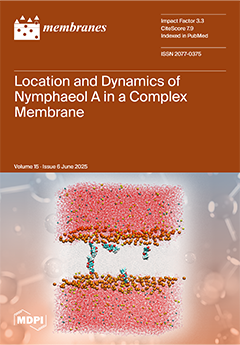Recycling extracellular polymeric substances (EPSs) from excess sludge in wastewater treatment plants has garnered significant research attention. Membrane separation offers a promising approach for EPS concentration; however, membrane fouling remains a critical challenge. Previous studies demonstrate that Ca
2+ addition effectively mitigates membrane
[...] Read more.
Recycling extracellular polymeric substances (EPSs) from excess sludge in wastewater treatment plants has garnered significant research attention. Membrane separation offers a promising approach for EPS concentration; however, membrane fouling remains a critical challenge. Previous studies demonstrate that Ca
2+ addition effectively mitigates membrane fouling. This study reveals that Ca
2+ mixing modes govern membrane fouling in the dead-end ultrafiltration of both the practical EPS and model EPS [sodium algiante (SA)]. The interaction mechanisms between Ca
2+ and the EPS under varied mixing conditions and their impact on filtration performance were systematically investigated. At a low Ca
2+ concentration, the addition sequence critically influenced colloidal particle sizes formed via Ca
2+-EPS interactions, altering the cake layer structure governing filtration resistance; these effects diminished at higher Ca
2+ concentrations. In suspensions prepared by adding EPS to Ca
2+ solution (EPS-Ca), a portion of the EPS became encapsulated within an EPS-Ca layer formed through Ca
2+ EPS binding, reducing free EPS concentration and enlarging colloidal aggregates. This encapsulation reduced EPS-mediated membrane fouling, thereby lowering filtration resistance. Conversely, in suspensions prepared by adding Ca
2+ to EPS solution (Ca-EPS), more complete Ca
2+ EPS interactions formed a dense crosslinked structure with smaller colloids on membrane surfaces, intensifying fouling and resistance. Additionally, EPS-Ca exhibited higher compressibility than Ca-EPS, though both exhibited comparable filtration resistance under high-pressure conditions. These results offer critical insights into optimizing EPS ultrafiltration concentration to mitigate membrane fouling through Ca
2+ addition strategies.
Full article






